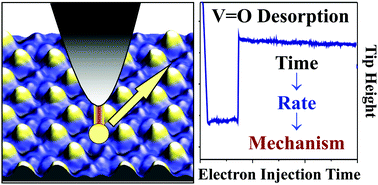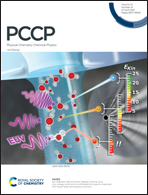Electron stimulated desorption of vanadyl-groups from vanadium oxide thin films on Ru(0001) probed with STM
Abstract
Low-temperature scanning tunnelling microscopy (STM) is employed to study electron-stimulated desorption of vanadyl groups from an ultrathin vanadium oxide film. The vanadia patches are prepared by reactive vapour deposition of V onto a Ru(0001) surface and comprise a highly ordered network of six and twelve membered V–O rings, some of them terminated by upright V![[double bond, length as m-dash]](https://www.rsc.org/images/entities/char_e001.gif) O groups. The vanadyl units can be desorbed via electron injection from the STM tip in a reliable fashion. From hundreds of individual experiments, desorption rates are determined as a function of bias voltage and tunnelling current. Data analysis reveals a distinct threshold behaviour with bias onsets at +3.3 V and −2.6 V for positive and negative polarity, respectively. The desorption rate varies quadratically (cubically) with the tunnelling current at positive (negative) sample bias, indicating that V
O groups. The vanadyl units can be desorbed via electron injection from the STM tip in a reliable fashion. From hundreds of individual experiments, desorption rates are determined as a function of bias voltage and tunnelling current. Data analysis reveals a distinct threshold behaviour with bias onsets at +3.3 V and −2.6 V for positive and negative polarity, respectively. The desorption rate varies quadratically (cubically) with the tunnelling current at positive (negative) sample bias, indicating that V![[double bond, length as m-dash]](https://www.rsc.org/images/entities/char_e001.gif) O desorption is a many-electron process. Based on our findings, a mechanism for desorption is proposed that includes resonant tunnelling into anti-bonding or out of bonding orbitals, followed by vibrational ladder climbing in the binding potential of the V
O desorption is a many-electron process. Based on our findings, a mechanism for desorption is proposed that includes resonant tunnelling into anti-bonding or out of bonding orbitals, followed by vibrational ladder climbing in the binding potential of the V![[double bond, length as m-dash]](https://www.rsc.org/images/entities/char_e001.gif) O ad-system. The underlying electronic states can be identified directly in the STM conductance spectra taken on the oxide surface.
O ad-system. The underlying electronic states can be identified directly in the STM conductance spectra taken on the oxide surface.



 Please wait while we load your content...
Please wait while we load your content...